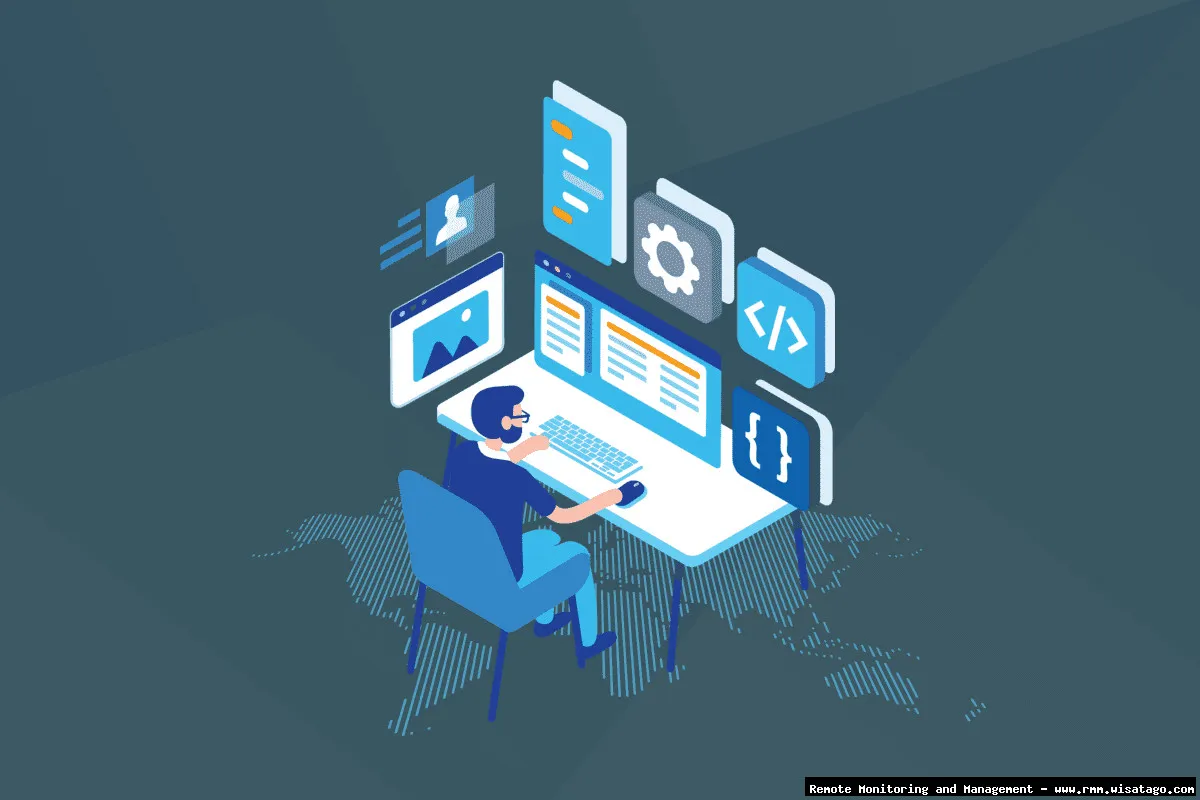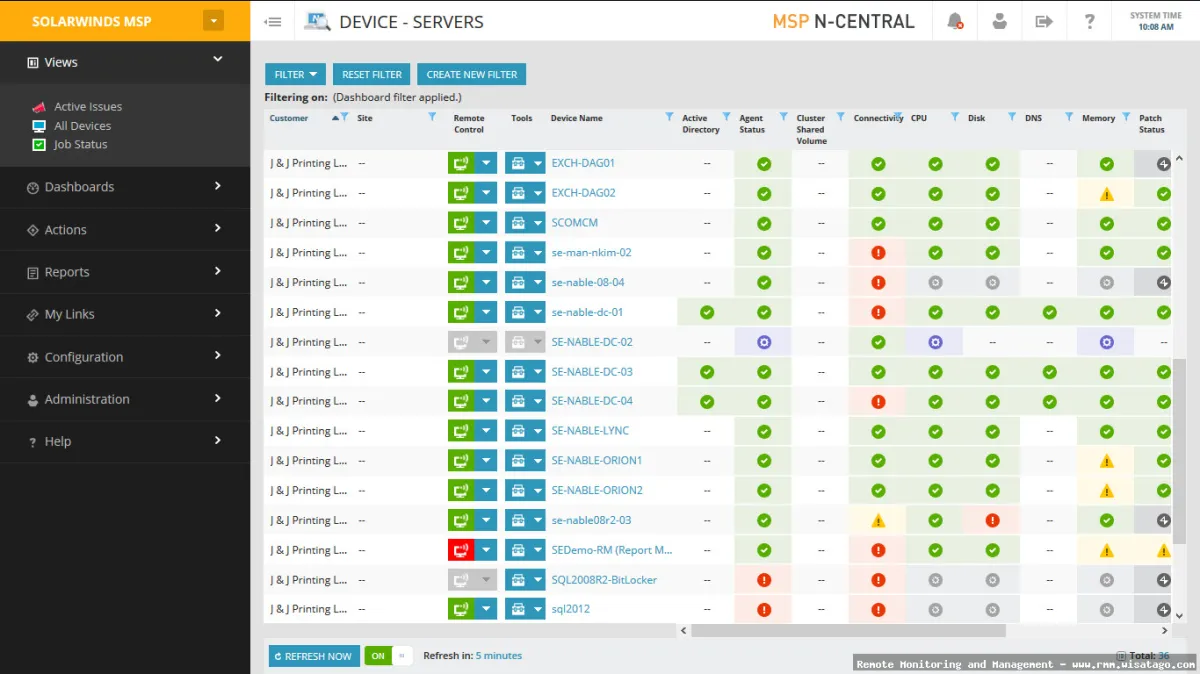In today’s fast-paced IT landscape, managing a growing number of endpoints and ensuring seamless operations can feel like herding cats. Whether you’re supporting a small business with a handful of employees or a large enterprise with a global footprint, the challenges are similar: keeping systems secure, up-to-date, and performing optimally. That’s where Remote Monitoring and Management (RMM) platforms come in, offering a centralized solution for managing IT infrastructure remotely. But not all RMMs are created equal. The real power lies in those platforms that offer advanced automation capabilities, allowing IT professionals to streamline tasks, proactively address issues, and free up valuable time for strategic initiatives.
Think of it this way: traditional IT management is like manually watering each plant in your garden. It’s time-consuming, inefficient, and prone to errors. An RMM platform is like installing an automated irrigation system. You set the parameters, and the system takes care of the watering, adjusting to changing conditions and alerting you to any potential problems. An RMM with advanced automation takes it a step further. It analyzes soil moisture levels, detects plant diseases early, and even adjusts fertilizer levels automatically, ensuring optimal growth with minimal intervention. This analogy perfectly captures the essence of what advanced automation brings to the table – a proactive, intelligent, and efficient approach to IT management.

This article dives deep into the world of RMM platforms with advanced automation capabilities. We’ll explore what makes them different, the key features to look for, the benefits they offer, and the challenges you might encounter when implementing them. We’ll also discuss some real-world use cases and provide guidance on choosing the right RMM solution for your specific needs. So, if you’re looking to transform your IT management from reactive to proactive and unlock the true potential of automation, read on!
What are RMM Platforms with Advanced Automation?
At its core, an RMM (Remote Monitoring and Management) platform is a software solution designed to help IT professionals remotely monitor and manage their clients’ or their own IT infrastructure. This includes servers, desktops, laptops, mobile devices, and even network devices like routers and switches. Traditionally, RMMs focused on basic monitoring tasks like tracking system uptime, performance metrics (CPU usage, memory consumption, disk space), and security alerts. They also provided remote access capabilities, allowing technicians to troubleshoot issues without physically being on-site.
The Evolution to Advanced Automation
However, the demands of modern IT environments have pushed RMMs to evolve. Advanced automation capabilities are now a crucial differentiator. These capabilities go beyond simple monitoring and remote access by automating repetitive tasks, proactively addressing potential issues, and streamlining complex workflows. This involves scripting, policy-based management, and integration with other IT tools.
Think of it as moving from simply observing the health of your systems to actively improving it. Instead of just getting an alert when a server’s CPU usage is high, an RMM with advanced automation can automatically restart the server, increase its resources, or even migrate workloads to a less stressed machine. This level of automation reduces the need for manual intervention, minimizes downtime, and improves overall IT efficiency.
Key Features of RMM Platforms with Advanced Automation
When evaluating RMM platforms with advanced automation, several key features should be considered:
Scripting and Task Automation
This is the foundation of advanced automation. RMMs should support scripting languages like PowerShell, Python, or Bash, allowing IT professionals to create custom scripts to automate a wide range of tasks. These tasks can include software installations, patch deployments, system configurations, and even complex troubleshooting procedures. The ability to schedule these scripts to run automatically at specific times or in response to certain events is also crucial.
Policy-Based Management
Policy-based management allows you to define rules and policies that govern the behavior of your IT systems. For example, you can create a policy that automatically installs security updates on all Windows servers or that restricts access to certain websites on company laptops. The RMM platform should automatically enforce these policies, ensuring compliance and security across your entire infrastructure. This also helps maintain a consistent configuration, reducing the risk of configuration drift and related issues.
Automated Patch Management
Keeping software up-to-date with the latest security patches is essential for protecting against vulnerabilities. An RMM with automated patch management should be able to automatically detect missing patches, download and install them, and reboot systems as needed. This process should be highly customizable, allowing you to define specific patch deployment schedules and exclude certain patches if necessary.
Proactive Monitoring and Alerting
While basic RMMs provide monitoring and alerting capabilities, advanced RMMs go further by using machine learning and artificial intelligence to identify potential issues before they escalate. For example, they can detect unusual patterns in system performance that might indicate a security breach or a hardware failure. The alerting system should be highly configurable, allowing you to define different alert thresholds and notification methods for different types of events.
Self-Healing Capabilities
Some RMM platforms offer self-healing capabilities, which allow them to automatically resolve certain types of issues without human intervention. For example, if a server’s CPU usage exceeds a certain threshold, the RMM might automatically restart the server or kill a runaway process. This can significantly reduce downtime and improve overall system stability.

Integration with Other IT Tools
An RMM platform should integrate seamlessly with other IT tools, such as ticketing systems, security information and event management (SIEM) solutions, and cloud platforms. This integration allows you to streamline workflows, automate incident response, and gain a more holistic view of your IT environment.
Reporting and Analytics
Comprehensive reporting and analytics are essential for understanding the health and performance of your IT infrastructure. The RMM platform should provide a variety of reports that track key metrics such as system uptime, patch compliance, security vulnerabilities, and resource utilization. These reports can help you identify areas for improvement and make data-driven decisions.
Benefits of Using RMM Platforms with Advanced Automation
The benefits of adopting RMM platforms with advanced automation are numerous and can significantly impact an organization’s IT operations:
Increased Efficiency and Productivity
By automating repetitive tasks, RMM platforms free up IT professionals to focus on more strategic initiatives. This leads to increased efficiency and productivity, allowing IT teams to accomplish more with fewer resources.
Reduced Downtime
Proactive monitoring and self-healing capabilities help prevent downtime by identifying and resolving issues before they escalate. This ensures business continuity and minimizes the impact of IT outages.
Improved Security
Automated patch management and policy enforcement help improve security by ensuring that systems are up-to-date with the latest security patches and that security policies are consistently enforced across the entire infrastructure.
Reduced Costs
By automating tasks, reducing downtime, and improving security, RMM platforms can help reduce IT costs. This includes reduced labor costs, lower hardware maintenance costs, and fewer security breaches.
Enhanced Compliance
Policy-based management and comprehensive reporting help ensure compliance with industry regulations and internal policies. This reduces the risk of fines and penalties.
Better Scalability
RMM platforms allow you to easily scale your IT operations as your business grows. They provide a centralized platform for managing a growing number of endpoints and automating tasks across multiple locations.
Challenges of Implementing RMM Platforms with Advanced Automation
While the benefits of RMM platforms with advanced automation are significant, there are also some challenges to consider:

Complexity
Implementing and configuring an RMM platform can be complex, especially for organizations with limited IT resources. Proper planning, training, and documentation are essential for a successful implementation.
Cost
RMM platforms can be expensive, especially for small businesses. It’s important to carefully evaluate the features and pricing of different platforms to find the best fit for your budget.
Security Risks
If not properly secured, an RMM platform can become a target for cyberattacks. It’s important to implement strong security measures, such as multi-factor authentication and regular security audits, to protect the RMM platform and the systems it manages.
Over-Automation
While automation is beneficial, it’s important to avoid over-automating tasks that require human judgment. Some tasks, such as complex troubleshooting or incident response, may require a human touch to ensure the best outcome.
Integration Issues
Integrating an RMM platform with other IT tools can be challenging, especially if the tools are not designed to work together. Careful planning and testing are essential to ensure seamless integration.
Real-World Use Cases of RMM with Advanced Automation
To illustrate the practical applications of RMM with advanced automation, consider these real-world use cases:
Automated Onboarding and Offboarding
When a new employee joins the company, the RMM can automatically provision their account, install necessary software, and configure their device. When an employee leaves, the RMM can automatically revoke their access, wipe their device, and archive their data. This streamlines the onboarding and offboarding process and reduces the risk of security breaches.
Proactive Server Maintenance
The RMM can automatically monitor server performance, detect potential issues such as high CPU usage or low disk space, and take corrective action. For example, it can automatically restart a server if it becomes unresponsive or automatically increase disk space if it’s running low. This helps prevent server outages and ensures business continuity.
Automated Security Incident Response
If the RMM detects a security incident, such as a malware infection or a suspicious login attempt, it can automatically take steps to contain the incident. For example, it can automatically isolate the infected device from the network, disable the user’s account, and alert the security team. This helps minimize the impact of security incidents and prevent them from spreading.
Remote Software Deployment and Updates
The RMM can be used to remotely deploy software to multiple devices simultaneously. This is especially useful for deploying updates, patches, and new applications across the network. This ensures that all devices are running the latest software versions, improving security and performance.

Choosing the Right RMM Platform
Selecting the right RMM platform is a crucial decision that can significantly impact your IT operations. Here are some factors to consider:
Your Specific Needs and Requirements
Start by clearly defining your specific needs and requirements. What tasks do you want to automate? What types of devices do you need to manage? What level of security do you require? What is your budget?
Features and Functionality
Evaluate the features and functionality of different RMM platforms. Make sure the platform offers the features you need, such as scripting, policy-based management, automated patch management, and proactive monitoring. For more information, you can refer to RMM as an additional resource.
Scalability
Choose a platform that can scale to meet your growing needs. Make sure the platform can handle a growing number of endpoints and users without performance degradation.
Ease of Use
Select a platform that is easy to use and configure. The platform should have a user-friendly interface and comprehensive documentation.
Integration Capabilities
Ensure that the platform integrates seamlessly with your existing IT tools, such as ticketing systems, security information and event management (SIEM) solutions, and cloud platforms.
Vendor Support
Choose a vendor that offers excellent customer support. Make sure the vendor has a responsive support team and provides comprehensive training and documentation.
Pricing
Compare the pricing of different RMM platforms. Consider the total cost of ownership, including licensing fees, implementation costs, and ongoing maintenance costs.
Conclusion
RMM platforms with advanced automation capabilities are transforming the way IT professionals manage their infrastructure. By automating repetitive tasks, proactively addressing issues, and streamlining complex workflows, these platforms can significantly improve IT efficiency, reduce downtime, enhance security, and lower costs. While there are challenges to consider when implementing these platforms, the benefits far outweigh the risks. By carefully evaluating your needs, choosing the right platform, and implementing it effectively, you can unlock the true potential of automation and transform your IT operations from reactive to proactive.
The future of IT management is undoubtedly automated. Embrace the power of RMM platforms with advanced automation and empower your IT team to focus on strategic initiatives that drive business growth.

Conclusion
In conclusion, RMM platforms with advanced automation capabilities are no longer a luxury, but a necessity for MSPs and IT departments seeking to thrive in today’s complex IT landscape. The ability to proactively monitor, manage, and remediate issues remotely, coupled with the power of automation, allows for significant gains in efficiency, reduced downtime, and improved overall service delivery. By strategically leveraging these platforms, organizations can free up valuable IT resources to focus on strategic initiatives and innovation, ultimately driving business growth and enhancing customer satisfaction.
The discussed RMM platforms represent a significant step forward in IT management, offering a compelling blend of robust features and streamlined workflows. As the IT environment continues to evolve, the need for sophisticated automation will only intensify. Therefore, we encourage you to explore the capabilities of these advanced RMM solutions and consider how they can transform your IT operations. Take the next step towards a more efficient and proactive IT management strategy by scheduling a demo or requesting a free trial from one of the leading RMM vendors mentioned. You can also delve deeper into specific platform features and benefits by visiting their websites and downloading informational resources. Don’t let outdated IT management practices hold you back.
Frequently Asked Questions (FAQ) about RMM Platforms with Advanced Automation Capabilities
What are the key benefits of using an RMM platform with advanced automation capabilities for managed service providers (MSPs)?
Using an RMM platform with advanced automation offers numerous benefits for MSPs. Primarily, it significantly improves efficiency. By automating routine tasks like patch management, software deployments, and system monitoring, technicians can focus on more complex and strategic issues. This reduces the time spent on repetitive tasks, freeing up valuable resources. Automation also minimizes human error, leading to more consistent and reliable service delivery. Furthermore, advanced automation can proactively identify and resolve issues before they impact end-users, improving overall uptime and customer satisfaction. In short, an RMM platform with strong automation capabilities allows MSPs to scale their operations, improve profitability, and deliver better service to their clients.
How can I use advanced automation features in an RMM platform to proactively prevent IT problems and reduce downtime for my clients?
Advanced automation within an RMM platform enables proactive problem prevention and downtime reduction through several mechanisms. Firstly, automated monitoring allows for real-time detection of performance anomalies and potential issues, such as high CPU usage or disk space limitations. Automated remediation scripts can then be triggered to address these issues before they escalate into full-blown problems. Secondly, automated patch management ensures that systems are always up-to-date with the latest security patches, minimizing vulnerability to exploits. Thirdly, automated maintenance tasks, like disk defragmentation and temporary file cleanup, keep systems running smoothly. By leveraging these automation features, MSPs can significantly reduce the risk of IT failures and ensure maximum uptime for their clients, leading to improved service levels and stronger client relationships.
What are some specific examples of advanced automation workflows I can create within an RMM platform to streamline IT management tasks?
Many advanced automation workflows can be implemented within an RMM platform to streamline IT management. One example is automated onboarding: when a new device is detected, the RMM can automatically install necessary agents, configure security settings, and deploy baseline software. Another useful workflow is automated software deployment: new software or updates can be rolled out to groups of devices based on predefined schedules or triggers. A third example is automated remediation of common issues: if a server’s CPU usage exceeds a threshold, the RMM can automatically restart the affected service or escalate the issue to a technician. Finally, automated reporting can generate regular performance reports, security audits, and compliance summaries, providing valuable insights without manual effort. These workflows help to reduce manual intervention, improve efficiency, and ensure consistent IT management practices.